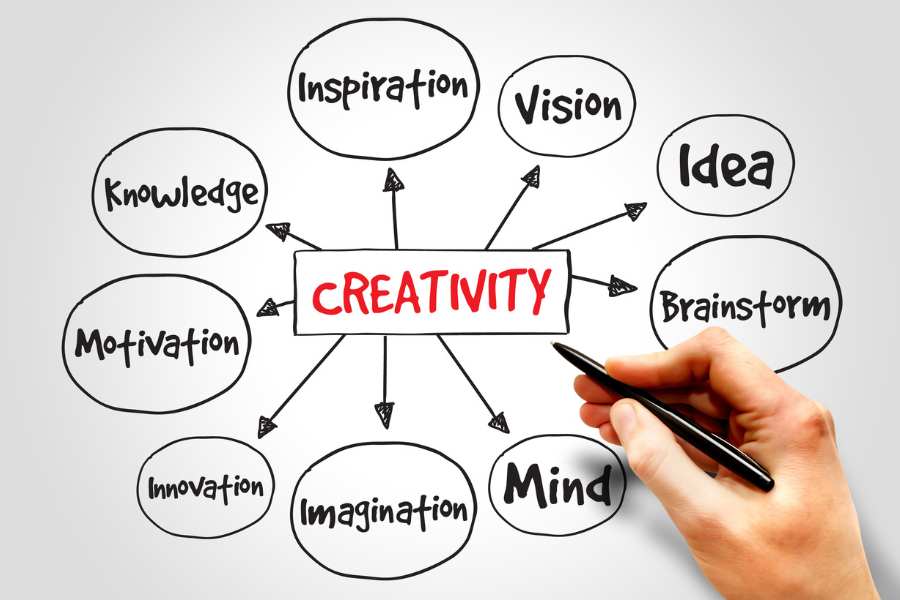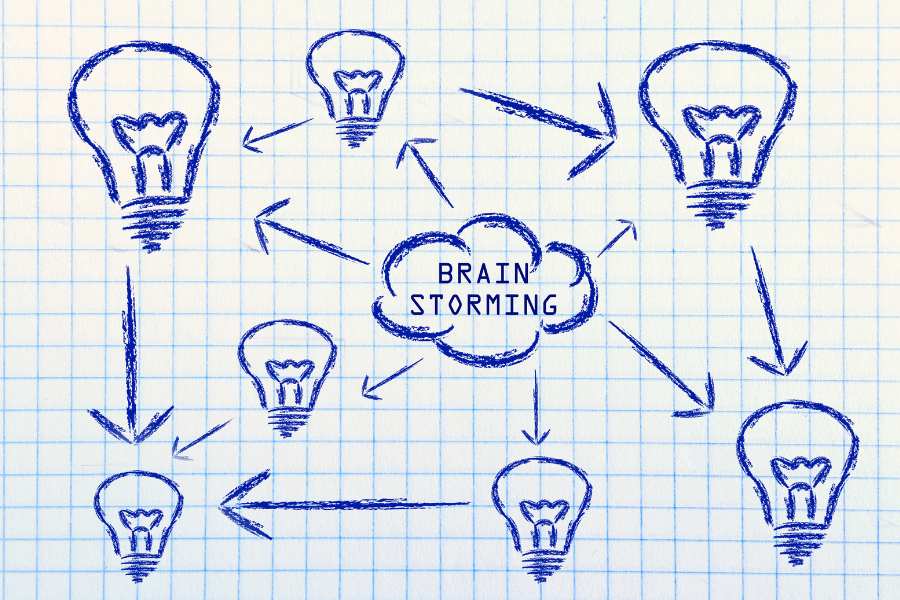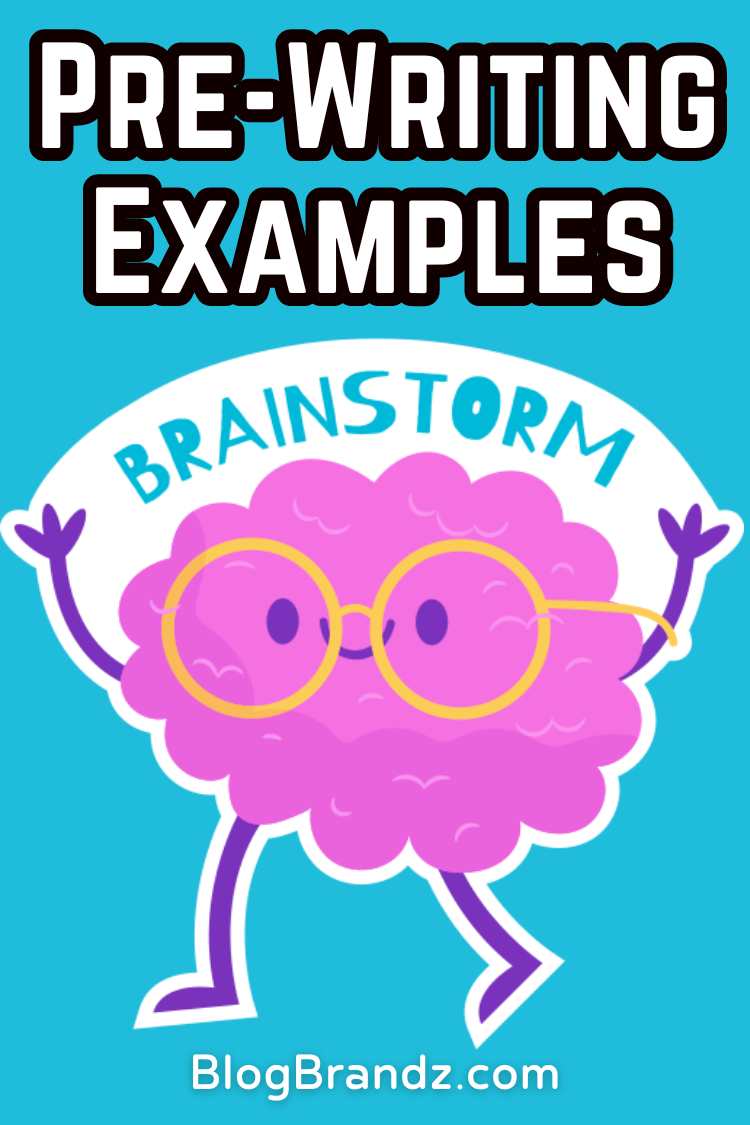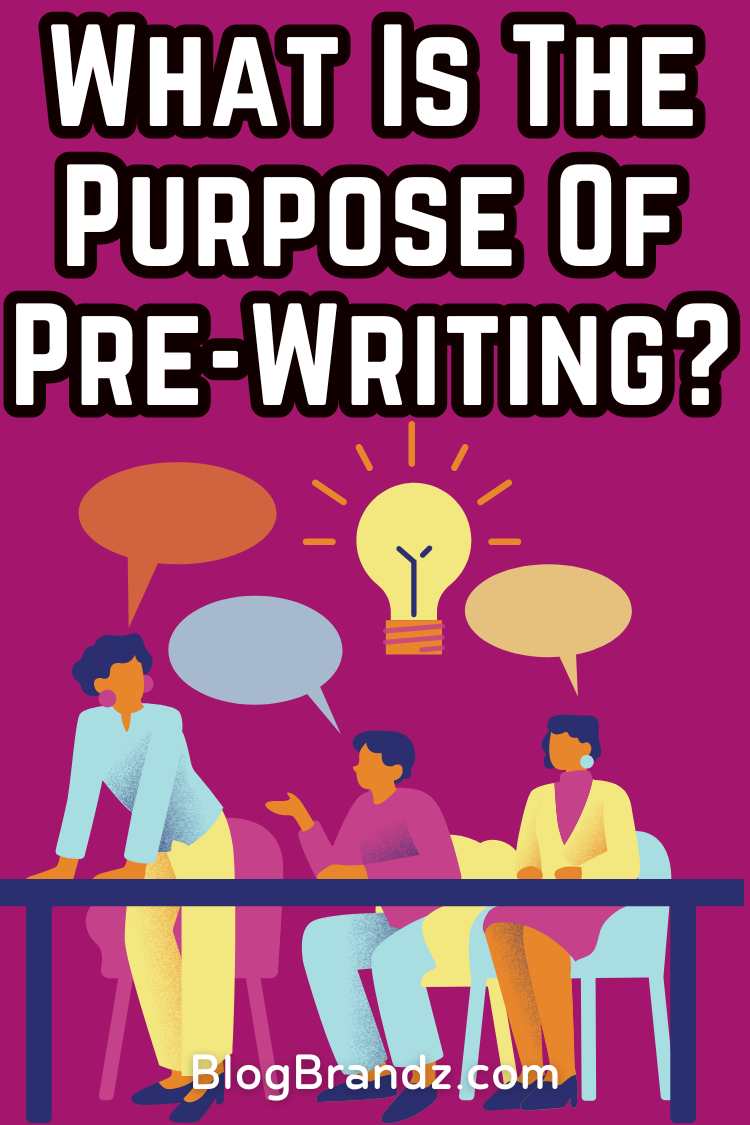Discover how to brainstorm, organize thoughts, and develop ideas effectively with essential pre-writing techniques for writers and authors.
Embarking on a writing journey can be exhilarating, but challenging. The writing process requires careful planning and preparation, from brainstorming ideas to organizing thoughts and finally putting pen to paper.
This is where pre-writing techniques come into play, serving as the foundation of great writing. This article explores pre-writing techniques writers and authors can use to think critically, develop ideas, and lay the groundwork for their writing projects.
Whether you’re a seasoned writer looking to refine your process or a novelist looking for ideas for plot priming (the name for novel notes pre-writing) these techniques will help you harness your creativity and approach your writing with clarity and purpose.
Contents
What is Pre-Writing?
Pre-writing, meaning the process of preparing and planning before you start writing, includes activities that help writers generate ideas, organize thoughts, clarify their message, and create a solid foundation for their writing.
During the pre-writing stage, an author will determine the purpose and audience of their writing, develop a clear thesis or main idea, gather and organize relevant information, outline the structure of their piece, and consider the tone and style that will best suit their purpose and audience.
Structured pre-writing practice is essential for organizing ideas and planning the content of a writing project before beginning the actual writing process.
What is the Purpose of Pre-Writing?
The pre-writing process is crucial for laying the groundwork for a successful writing project. It’s an important step that can help writers improve their writing skills.
Pre-writing is important for all of the following reasons:
#1. Generating Ideas
Pre-writing helps brainstorm and organize ideas before putting them into a cohesive form. This can prevent writer’s block and ensure your writing stays focused and on track.
For example, before writing an essay on climate change, a writer might use brainstorming techniques to generate a list of potential topics, such as the causes of climate change, its impact on the environment, and possible solutions.
The writer would then organize these ideas into a coherent outline, ensuring that each topic is clearly defined and supports the main thesis. By structuring the pre-writing process, the writer can prevent writer’s block and ensure the final piece is well-organized and focused.
#2. Organizing Thoughts
Organizing thoughts is a key aspect of structured pre-writing. It allows writers to organize their thoughts and ideas logically, which makes the writing process smoother and more coherent.
For instance, before drafting a research paper on renewable energy sources, a writer might use outlining to organize their thoughts into main topics (e.g., solar power, wind energy, hydropower) and subtopics (e.g., benefits, drawbacks, technological advancements).
This process ensures the writer has a clear roadmap, making the overall process smoother, and resulting in a more coherent and well-structured final piece.
#3. Improving Clarity
Improving clarity is another benefit of structured pre-writing. By planning your writing, you can ensure that your ideas are communicated to your audience, making your writing more effective.
For example, before writing a persuasive speech advocating for stricter environmental regulations, a speaker might use pre-writing techniques to clarify their main arguments and supporting evidence.
By organizing these ideas cohesively, the speaker can ensure their message is clear and impactful, increasing the likelihood of persuading their audience.
#4. Saving Time
Saving time is a significant advantage of structured pre-writing. Pre-writing can save time by helping you avoid unnecessary revisions. Having a clear plan can help you write more efficiently and effectively.
For instance, before writing a business proposal for a new product, an entrepreneur might use pre-writing techniques to outline the key features, target market, and competitive analysis.
With a clear plan, the entrepreneur can write the proposal more efficiently, reducing the need for extensive revisions later. This saves time and ensures that the final proposal is well-organized and persuasive.
#5. Enhancing Creativity
Structured pre-writing can enhance creativity by providing a platform to explore different ideas and approaches before committing to a specific direction.
For example, before starting a short story, a writer might use pre-writing exercises like brainstorming or freewriting to generate multiple plot ideas or character concepts.
This exploration can lead to unexpected and innovative storylines that the writer may not have considered otherwise. This creative exploration in structured pre-writing results in a more engaging and original final piece.
11 Pre-Writing Techniques for Writers & Authors
Writers can use several pre-writing techniques to prepare for the writing process. Some common pre-writing strategies to think critically and develop ideas include brainstorming, outlining, freewriting, clustering, and using graphic organizers.
#1. Brainstorming
Brainstorming is a creative technique that can help writers generate ideas and overcome mental blocks. It involves generating ideas on a specific topic without worrying about organization or structure.
Here are some techniques you can use to improve your brainstorming and pre-writing skills:
- Set a Time Limit: Give yourself a specific amount of time, such as 10-15 minutes, to brainstorm. This helps prevent overthinking and encourages a free flow of ideas.
- Use Mind Mapping: Create a visual representation of your ideas using a mind mapping tool or pen and paper. Start with a central topic or question and branch out with related ideas.
- Try Listing: Simply list out all ideas that come to mind related to your topic. Don’t worry about the order or coherence at this stage; the goal is to capture as many ideas as possible.
- Use Prompt Questions: Use questions like “What if?”, “Why?”, or “How?” to stimulate different angles and perspectives on your topic.
- Combine and Expand Ideas: Look for connections between ideas and expand on them. For example, if you’re brainstorming blog post ideas, you could combine two ideas to create a more comprehensive topic.
- Use Online Tools: Online brainstorming tools such as MindMeister, Coggle, and Bubbl.us, can help you organize and visualize your ideas.
- Collaborate: If possible, brainstorm with others. Group brainstorming sessions can generate a wider range of ideas and perspectives.
Here are some brainstorming courses with exercises to boost your creativity and brainstorm new ideas:
- Certified Brainstorming Specialist Masterclass (Accredited)
- Brainstorming Strategies For Enhanced Cognitive Dominance®
- Become 10x More Confident in Your Ideas with Brainstorming
Remember, the goal of brainstorming is to generate a large quantity of ideas without judgment. You can then review and refine these ideas in the next stages of your writing process.
#2. Freewriting
Freewriting is a pre-writing exercise used as a warm-up practice to generate new ideas. It is a valuable technique for writers to overcome writer’s block and stimulate creativity.
Here are some actionable tips and resources for effective freewriting:
- Set a Timer: Choose a specific amount of time, such as 5-10 minutes, and commit to writing continuously during that period. This helps to keep your thoughts flowing without interruption.
- Don’t Edit or Revise: The key to freewriting is to write without stopping to edit or revise. Allow yourself to write freely, even if it means making grammatical errors or writing incomplete sentences.
- Write Anything: Write whatever comes to mind, even if it seems unrelated to your topic. The goal is to keep your pen moving and explore ideas without judgment.
- Focus on the Process: Instead of worrying about the quality of your writing, focus on the process of writing itself. Embrace the act of putting your thoughts into words without self-censorship.
- Use Prompts: If unsure where to start, consider using a writing prompt to kickstart your freewriting session. Prompts can be specific questions, phrases, or ideas to inspire your writing.
- Review and Reflect: After your freewriting session, take some time to review what you’ve written. You may discover new ideas or insights that can be developed further in your writing.
- Repeat Regularly: Freewriting can be a beneficial daily practice to keep your writing skills sharp and overcome creative blocks. Try to incorporate freewriting into your routine regularly.
Here are some courses to help you learn and practice freewriting:
- Five-Minute Writing Challenges: Extended Course
- The Artist’s Way Starter Kit by Julia Cameron
- Advanced Brainstorm Techniques
You can use online tools and apps that help facilitate freewriting, such as 750 Words, which provides a private space for daily freewriting sessions.
#3. Outlining
Outlining is a crucial step in the writing process that helps writers organize their thoughts and create a coherent structure for their pieces. It involves creating a structured plan for your writing, including main ideas, supporting details, and the overall organization of your piece.
Outlines can be hierarchical (using Roman numerals, letters, and numbers) or linear (using bullet points or dashes). Here are some actionable tips and resources for effective outlining:
- Identify Your Main Ideas: Identify the main ideas or arguments you want to convey in your writing. These will serve as the foundation for your outline.
- Organize Supporting Details: For each main idea, identify supporting details or evidence that will help strengthen your argument or narrative. These details should logically support your main points.
- Choose Your Outline Format: Decide on the format for your outline, whether hierarchical (using Roman numerals, letters, and numbers) or linear (using bullet points or dashes). Choose the format that best suits your writing style and the complexity of your piece.
- Be Flexible: Your outline is a guide, not a strict rule. Be open to adjusting your outline as you write and discover new ideas or connections.
- Use Online Tools: Online tools like Microsoft Word, Google Docs, or dedicated outlining software like Workflowy or Dynalist can help you create outlines.
- Include Transitions: Incorporate transitional phrases or sentences into your outline to ensure a smooth flow between ideas and sections.
- Review and Revise: Once you have completed your outline, review it carefully to ensure it effectively conveys your main ideas and supporting details. Make any necessary revisions to improve clarity and coherence.
These writing courses will show you how to organize your ideas and content into quality book outlines in minutes:
- Surfer’s Free AI Article Outline Generator
- SEMrush’s Free Outline Builder
- Start Your Book: Nonfiction Writer’s Roadmap [Outline Guide]
- Create an Entire Nonfiction Book Outline in Minutes
By following these tips and utilizing available resources, you can create a well-organized outline that serves as a roadmap for your writing project.
#4. Clustering or Mapping
Clustering, mapping, or webbing, involves creating a visual representation of ideas and their relationships. It’s a creative way to visually organize ideas and explore connections.
Clustering can help in organizing thoughts and seeing connections between different concepts. Here are some actionable tips and resources for effective clustering or mapping:
- Start with a Central Idea: Begin by writing your main idea or topic in the center of a paper or digital canvas. This will serve as the focal point of your cluster or map.
- Brainstorm Related Ideas: Around the central idea, jot down related ideas, concepts, or keywords. These can be branches extending outwards from the central idea.
- Draw Connections: Use lines or arrows to connect related ideas. This helps to visualize the relationships between different concepts and can spark new ideas.
- Group Similar Ideas: As you add more ideas to your cluster or map, you may notice that certain ideas are related or similar. Group these ideas together to create clusters within your overall map.
- Use Color or Symbols: To further organize your ideas, consider using different colors or symbols to differentiate between different categories or types of ideas.
- Add Detail: As your cluster or map grows, you can add more detail to each idea, including supporting points, examples, or arguments.
- Review and Refine: Once you have completed your cluster or map, review it to ensure that it effectively represents your ideas and their relationships. Make any necessary refinements to improve clarity and coherence.
- Digital Tools: There are many digital tools available that can help you create clusters or maps, such as MindMeister, XMind, or Coggle. These tools often offer additional features, such as collaborating or exporting your map to other formats.
These mind-mapping courses will help writers organize their thinking, visualize their thoughts, and understand information faster:
- Complete Mind Mapping Course: Beginner to Advanced Technique
- Mind Mapping Mastery: Effective Mind Maps Step-by-Step
- The Mind Mapping Experts MasterClass For Success
- Mind Mapping a Novel
Using clustering or mapping techniques will help you visually organize your ideas, explore connections between them, and create a solid foundation for your writing project.
#5. Research
Research is a critical component of the pre-writing process, especially for writing that requires factual accuracy and depth. This can involve gathering information from books, articles, interviews, or online sources.
For example, when pre-writing for an informative essay, try to generate relevant, accurate, and engaging ideas focused on providing factual information, explaining concepts clearly, and supporting the main thesis or argument of the essay.
Consider the needs and interests of the target audience ensuring that the information provided is accessible and valuable to them. Generating several ideas and perspectives can help make the essay more comprehensive and balanced.
Here are some actionable tips and resources for effective research:
- Define Your Research Questions: Start by clearly defining the questions you need to answer through your research. This will help you focus your efforts and gather relevant information.
- Use Credible Sources: When conducting research, use credible sources such as academic journals, books, reputable websites, and expert interviews. Avoid relying solely on unverified sources or opinions.
- Diversify Your Sources: Gather information from different sources to ensure a comprehensive understanding. This can include primary sources, secondary sources, and expert opinions.
- Take Notes: As you conduct your research, take detailed notes on key points, quotes, and sources. This will help you keep track of your sources and organize your thoughts later.
- Organize Your Research: Use tools like spreadsheets, reference managers (e.g., Zotero, Mendeley), or note-taking apps to organize your research materials and citations.
- Evaluate Your Sources: Before using information from a source, critically evaluate its credibility, relevance, and bias. Ensure that the information is accurate and supports your argument or thesis.
- Stay Organized: Keep track of all your research materials, including sources, notes, and citations, to avoid plagiarism and easily reference your sources in your writing.
- Ask for Help: If you’re struggling to find relevant information or understand a complex topic, don’t hesitate to ask for help from librarians, professors, or subject matter experts.
Learn how to conduct research with these courses:
By following these tips and utilizing available resources, you can conduct thorough and effective research to support your writing and enhance the quality of your work.
#6. Interviewing
When writing personal experiences or expert opinions, interviewing relevant individuals can be a valuable pre-writing activity that can provide firsthand information and unique perspectives for your writing.
Interviewing can help gather insights and quotes to include in your writing. Here are some actionable tips for conducting effective interviews:
- Identify Your Interviewees: Determine who you need to interview based on their expertise, experience, or relevance to your topic. This could include experts, professionals, or individuals with personal experiences related to your subject.
- Prepare Your Questions: Develop a list of open-ended questions that will encourage detailed responses and provide insights into your topic. Tailor your questions to each interviewee’s background and perspective.
- Set Up the Interview: Contact your interviewees to schedule a convenient time for the interview. Decide on the format (in-person, phone, video call) and duration.
- Conduct the Interview: Start the interview by introducing yourself and explaining the purpose of the interview. Ask your questions and listen attentively to the responses. Take notes or record the interview with permission.
- Ask Follow-Up Questions: If necessary, ask follow-up questions to clarify or expand on the interviewee’s responses. This can help you gather more detailed information and insights.
- Respect Privacy and Confidentiality: Respect the privacy and confidentiality of your interviewees. Ask for permission before using any personal or sensitive information in your writing.
- Thank Your Interviewees: After the interview, thank your interviewees for their time and insights. Offer to share a copy of your writing if they’re interested.
- Transcribe and Analyze: Transcribe your interviews and analyze the responses to identify key insights, quotes, or themes that you can incorporate into your writing.
Learn how to conduct interviews with these courses:
Interviewing can add depth and credibility to your writing by incorporating real-life experiences and expert opinions. By following these tips, you can conduct effective interviews that enhance the quality and impact of your writing.
#7. Reflecting or Journaling
Reflecting or journaling is a valuable pre-writing activity that can help writers clarify their thoughts, develop a deeper understanding of their topic, and identify key points to include in their writing.
Here are some actionable tips for effective reflection or journaling:
- Set Aside Regular Time: Schedule regular time for reflection or journaling in your writing process. This can be daily, weekly, or as needed.
- Write Freely: When journaling, write freely without worrying about grammar or structure. Allow your thoughts to flow naturally and explore different ideas and perspectives.
- Focus on Your Topic: Use your reflection or journaling time to focus on your writing topic. Consider different angles, viewpoints, and potential arguments related to your topic.
- Ask Yourself Questions: Pose questions to yourself about your topic to prompt deeper reflection. For example, “What are the main challenges in my topic?”, “What solutions have been proposed?”, or “How does my topic relate to current events?”
- Capture Ideas: Jot down any ideas or insights that come to mind during your reflection or journaling session. These ideas can later be developed into more detailed content for your writing.
- Review and Revise: After your reflection or journaling session, review your notes and ideas. Revise or expand on them as needed to further develop your thoughts.
- Use Prompts: If unsure where to start, use writing prompts to guide your reflection. There are many writing prompt resources available online or in writing books.
- Reflect on Your Progress: Use reflection or journaling to track your progress in your writing project. Reflect on what you have accomplished and set goals for the next steps.
Here are some courses to help you start journaling:
- The Artist’s Way Morning Pages Journal
- Journaling 101: Learn To Journal & Create a Journal Habit
- Kick Start Your Journaling Habit in Just 28 Days
- Strategic Journaling for Information
By incorporating reflection or journaling into your pre-writing routine, you can clarify your ideas, identify key points, and deepen your understanding of your writing topic.
#8. Discussing with Others
Discussing your ideas with peers, mentors, or instructors is a valuable pre-writing activity that can help clarify your thoughts, generate new ideas, and provide feedback and insights.
Here are some actionable tips for effective discussions:
- Choose Your Discussion Partners Wisely: Select individuals who are knowledgeable about your topic or who can provide valuable feedback. This could include peers, mentors, instructors, or subject matter experts.
- Prepare Your Ideas: Before the discussion, prepare a brief overview of your topic and the key points you want to discuss. This will help focus the discussion and make the most of your time.
- Listen Actively: During the discussion, listen carefully to the feedback and ideas of others. Be open to different perspectives and be willing to modify your ideas based on the feedback you receive.
- Ask for Specific Feedback: If you have specific questions or areas where you need feedback, ask for it directly. This will help guide the discussion and ensure you receive feedback.
- Take Notes: During the discussion, take notes on the feedback and ideas shared. This will help you remember the key points discussed and provide valuable insights for your writing.
- Follow-Up: After the discussion, follow up with your discussion partners to thank them for their time and to clarify any points that may still be unclear. This can also be an opportunity to share any updates or revisions to your ideas based on the discussion.
- Reflect on the Discussion: Reflect on the discussion and the feedback you received. Consider how you can incorporate this feedback into your writing and how it has helped clarify your thoughts.
Here are some courses to help you facilitate productive group discussions:
Discussions with others can help you gain valuable feedback, clarify your thoughts, and generate new ideas for your writing.
#9. Visualizing & Storyboarding
Visualizing your writing is a powerful pre-writing technique that can help you envision the final product and identify any gaps or areas that need further development.
This can be done through sketches, diagrams, or mental imagery. Here are some actionable tips for effective visualization:
- Create a Mental Image: Close your eyes and visualize what you want your final piece to look like. Imagine the structure, the main points, and how you want to convey your message to your audience.
- Use Sketches or Diagrams: If you’re a visual learner, consider sketching out the main ideas or structure of your writing. This can help you see the big picture and identify any missing elements.
- Storyboarding: With narrative writing, such as storytelling or scriptwriting, creating a storyboard by sketching out each scene or section of your writing can help visualize the flow and sequence of events.
- Mind Mapping: Use a mind mapping tool to create a visual representation of your ideas and how they are connected. This can help you see the relationships between separate concepts and organize your thoughts more effectively.
- Use Visual Aids: Incorporate visual aids, such as images, charts, or graphs, into your visualization process. This can help you convey complex information more clearly and engage your audience visually.
- Revise and Refine: As you visualize your writing, take note of any areas that seem unclear or underdeveloped. Use this visual feedback to revise and refine your ideas before starting the writing process.
- Share and Get Feedback: Once you have visualized your writing, consider sharing it with others to get feedback. This can help you identify blind spots and improve the overall quality of your writing.
Learn visualizing and storyboarding techniques with these courses:
- 21-Day Creative Visualization Project
- Storyboarding Techniques and Tips
- Storyboarding for Filmmakers & Content Creators
By visualizing your writing, you can clearly understand your ideas and how to best communicate them to your audience. This can lead to more effective and engaging writing.
#10. Annotating
Annotating as a pre-writing technique involves actively engaging with a text or source by highlighting important information, making notes, and asking questions.
This technique helps writers analyze and understand the text more deeply, which informs their writing.
For example, when annotating a research article, a writer might highlight key findings, jot down ideas for their research, and note any questions or areas that need further exploration.
Annotating can help writers generate ideas, organize their thoughts, and gather evidence to support their arguments, making it a valuable pre-writing strategy.
Here are some actionable tips and resources for using annotating as a pre-writing technique:
- Use Different Annotation Symbols: Develop a system of symbols (e.g., asterisks, question marks, arrows) to denote different types of annotations, such as important points, questions, connections to other ideas, or areas for further research.
- Highlight Key Information: Use a highlighter or colored pens to mark important passages or quotes you may want to include in your writing.
- Take Margin Notes: Write brief notes in the margins of the text to summarize key points, jot down ideas, or record your reactions and thoughts.
- Use Sticky Notes: If you prefer not to write directly on the text, use sticky notes to annotate important sections and jot down notes.
- Engage in Dialogue: Write comments or questions in the margins as if you were in conversation with the text. This can help you clarify your thoughts and generate ideas for your writing.
- Organize Annotations: Use different colors or symbols to organize your annotations by theme, topic, or relevance to your writing project.
- Review and Reflect: After annotating, review your annotations to identify common themes, connections, or ideas that can inform your writing. Reflect on how the text relates to your own ideas and arguments.
- Digital Annotation Tools: There are many digital tools available for annotating texts, such as Adobe Acrobat, and Microsoft Word, or online tools like Hypothesis. These tools allow you to annotate PDFs or digital texts and save your annotations for later reference.
Here are some note-taking courses to elevate your pre-writing annotation skills:
- Structured Note Taking Vol 1: Create an Ideas Bank
- The Science of Taking Great Notes: Natural Observation
- Strategic Note-taking for Information
Using these tips and resources will help you effectively use annotating as a pre-writing technique to deepen your understanding of texts, generate ideas, and prepare for your writing project.
#11. Keyword Research
Keyword research can be considered a pre-writing technique, especially for content creators who write for online platforms such as blogs, websites, or articles optimized for search engines.
It involves identifying the words and phrases people type into search engines to find information about your topic.
By conducting keyword research before writing, writers can gain insights into what their target audience is searching for and tailor their content to meet their needs.
This can help writers generate ideas, optimize their content for search engines, and improve the visibility and reach of their writing.
Here are some actionable tips for conducting keyword research:
- Understand Your Audience: Start by understanding your target audience and their needs. Identify the topics and keywords they are likely to use when searching for information related to your content.
- Use Keyword Research Tools: Utilize keyword research tools such as Google Keyword Planner and SEMrush to discover relevant keywords and phrases. These tools can provide insights into search volume, competition, and related keywords.
- Focus on Long-Tail Keywords: Long-tail keywords are longer and more specific phrases that often have less competition. Targeting long-tail keywords can help you attract more qualified traffic to your content.
- Consider Search Intent: Think about the search intent behind the keywords. Are people looking for information, trying to make a purchase, or looking for a specific solution? Tailor your content to match the intent behind the keywords.
- Competitor Analysis: Analyze the keywords that your competitors are targeting. This can provide valuable insights into which keywords drive traffic to their content.
- Create a Keyword List: Compile a list of relevant keywords and phrases you can use in your content. Organize the list based on relevance, search volume, and competition.
- Use Keywords Naturally: Incorporate your chosen keywords naturally into your content. Avoid keyword stuffing, as this can negatively impact the readability and quality of your content.
- Monitor and Refine: Create a content audit report to monitor the performance of your keywords using analytics tools. Refine your keyword strategy based on performance data to improve your content’s visibility and effectiveness.
Here are some tools and resources to help you conduct keyword research before writing SEO content:
- Surfer’s Keyword Research Tool
- Surfer SEO Content Editor
- Free Surfer SEO Writing Masterclass
- Surfer’s Free AI Article Outline Generator
- SEO Copywriting Certification Course
- How to Create a Content Audit Report
Follow these tips to conduct effective keyword research to optimize your content for search engines and attract more traffic to your writing.
These structured pre-writing exercises and techniques can be used individually or in combination to suit the writer’s preferences and the nature of the writing task.
Creative Writing Tips & Tools
- Free creative writing classes & creative writing courses
- Free book writing software & writing apps for creative writers
- How to be creative & let the creative process flow
- The art of creative thinking: how to enhance creativity
- How to learn creative writing skills and be a better writer
- How to use a story generator AI to write a story
- How to overcome and deal with writer’s block
- How to find the best content writing topics to write about
- How to use ChatGPT for writers (with ChatGPT prompts)
- 18 types of writing skills and how to learn them
- Speech writing checklist for drafting a speech
- How to master academic writing skills for career success
- How to learn lucid dreaming for creativity & personal growth
© 2024, Priya Florence Shah. All rights reserved.
Priya Florence Shah is a bestselling author and an award-winning blogger. Check out Devi2Diva, her book on emotional self-care for women. In her spare time, Priya writes science-fiction novels and poetry and chills with her two-legged and four-legged kids.
Discover more from Business & Branding Tips
Subscribe to get the latest posts to your email.



















